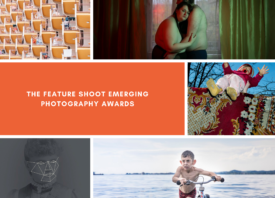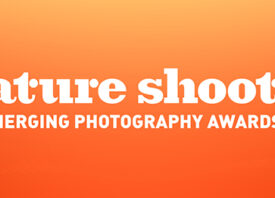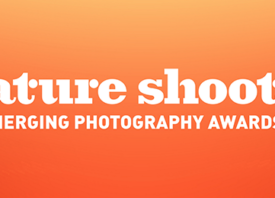Search this site
Announcing the Winners of The Feature Shoot Emerging Photography Awards!

We’re thrilled to announce the winners of the 2019 Feature Shoot Emerging Photography Awards. Now in its fifth year, our international competition drew hundreds of outstanding submissions, and in the end, our judges selected thirty-one photographers to be part of our upcoming group show at Aperture Gallery in Chelsea, New York on January 23, 2020 from 6-8PM.
This year’s jury included Jessie Wender, Photo Editor at The New York Times; Elissa Curtis, Deputy Photo Director at Wall Street Journal; Toby Kaufmann, Creative Director at Facebook; Anna Dickson, Visual Lead at Google Image Search; Clinton Cargill, previously of Vanity Fair, Bloomberg Businessweek, and The New York Times; and Alison Zavos, the founder of Feature Shoot. Together, they chose photographers from around the world, with home-bases in the United States, Canada, the United Kingdom, Germany, Switzerland, France, Poland, Greece, Italy, Russia, Ukraine, Hong Kong, South Korea, and beyond.
This year’s winning photos touch on intimate stories about identity, sexuality, friendship, and illness, and they explore the nuanced histories of nations and communities around the world. Some give voice to the marginalized and oppressed, and others illuminate some of the most pressing issues of our time, ranging from women’s rights to privacy to climate change. Still more examine the formal capabilities and the future of photography as a medium.
Maximilian Mann has been chosen by Alison Zavos to win the cash prize of $3,000 to continue his photography project on Lake Urmia, Iran.
Read about all thirty-one exhibiting photographers below, and see the work in person this month at Aperture Gallery.

In ‘Fading Flamingos’, the German photographer Maximilian Mann sheds light on the environmental disaster currently unfolding in Lake Urmia, Iran. The lake is drying out due to pressures from climate change and water consumption within the agricultural field, and residents in the surrounding villages are losing their livelihoods–and homes.
“Where ten years ago the waves splashed against the walls of the villages, today you see an almost endless desert,” Mann writes. “Ships that once brought people from one side of the lake to the other now lie like stranded whales on the shore, decaying. Within a few years, the surface area of the lake has shrunk by 80 percent. If this disaster is not stopped, up to five million residents could be forced to leave the area in the future.”

In ‘No shame’, the Saint-Petersburg-based photographer Mary Gelman shares the stories of people in Russia who have experienced discrimination and fatphobia firsthand–in their personal and professional lives.
“The problem of discrimination against fat people in Russia is not made up. They face job search rejections, medical prejudice, they receive lower salaries than people with ‘normal’ weight,” Gelman writes. “Fatphobia is not about beauty or health, it is about power and control over other people’s lives.
“As a result, being exposed to fat shaming and public disapproval on a regular basis causes stress, which in its turn leads to eating disorders, internalized fatphobia, feeling of guilt and shame for your own existence, depression and suicidal behavior.
“The subjects of the project are people of different genders and sexualities, different occupations and professional activities. They refuse to stay silent and put up with the system that makes millions of human lives miserable.”

In his project about the DPRK, the Hong Kong-based artist Ted Lau pulls back the curtains to reveal an enigmatic nation. Contemplating themes like freedom, identity, and isolation, he leans into the inherent surrealism of this place, while also highlighting the individual people who call it home. “In media, there are plenty of news and opinions about the country,” he writes. “But for me it was still shrouded in mystery and I wanted to learn more about this isolated land.”

The Los Angeles-based artist Clifford Prince King gives voice to the experience of queer Black men by highlighting the intersections between masculinity, intimacy, and vulnerability. Rooted in empathy and empowerment, his work recalls the history of fine art and the written word (he’s been compared to Langston Hughes, James Baldwin, and Jean-Michel Basquiat) while also charting a fresh and unexplored path that’s wholly his own.

In ‘Portraits of Bob Coombs’, the Brooklyn-based photographer Joey Solomon finds inspiration and affirmation his dear friend Robert Andy Coombs, a gay man living in a wheel chair–and explores his own life, struggles, and triumphs in the process.
“After becoming wheelchair bound, I found little will to live on,” Solomon writes. “I began creating images toward this series during a period when I was newly able to walk on my own again physically. Mentally, I was facing new demons; recently diagnosed with PTSD, Panic Episodic Disorder, Insomnia and Acute Social Anxiety as a result of being hospitalized for a tumor for 91 days in 2018.
“This period of my life granted me the beginnings of strong soul connections and in some ways, my sickness was the best thing that ever happened to me. Feeling sluggish and emotionally raw is no new territory for me, but dealing with the lasting physical pain in my legs made me appreciate and analyze human behavior and how we as a species treat those who cannot travel upright.”

In his series ‘Somaliland’, the German photographer Ingmar Björn Nolting takes us on a journey to a region in the north Somalia, where–despite surrounding conflicts–the people have found a way to live and coexist in peace.
“The borders of Somaliland go back to the area of the former British protectorate, which united with Italian-Somaliland to Somalia in 1960. Under the dictatorship of Barre, who seized power through a putsch nine years later, the inhabitants of the north felt increasingly deprived,” Nolting writes. “The resulting fights of the guerilla group ‘Somaliland National Movement’ against the troops of Barre culminated in the overthrow of the regime, the adoption of a declaration of independence and the founding of the Republic of Somaliland on 18 May 1991.
“Although Somaliland‘s independence is not recognized under international law, it managed to build up a state from ruins, a state with a democratic structure. With my photo essay, I want to take a surprising look at an often-overlooked region, which has been seeking international recognition for 28 years and where nothing seems more important than the young peace.”

In ‘Recognition Patterns’, the Washington-based artist Marcus DeSieno gives us a uniquely humorous and haunting look at life in a world that’s been reshaped by technology. “This is a body of work investigating the invisible architecture of computer vision in the 21st century and its impact on our freedoms,” he writes. “Power, farce, and absurdity are blended together in custom recognition algorithms built for, and then applied to, a personal archive of found photographs from the 19th and early 20th century.
“These photographs in the archive have long since lost their original meaning to time, and this series brings them into a digital sphere and transforms them through modern mechanisms of control using machine sight and facial recognition. Allusions to power and authority are embedded in each piece to ask what the future holds for us as this technology continues to evolve—for better or worse.”

Following in the tradition of Cindy Sherman and Juno Calypso, Jennifer Kesteleyn expands upon the history and heritage of female self-portraiture with her series ‘She must be on her period’.
“This body of works tries to visualise the subtle prejudices that still exist vis-a-vis women in contemporary society,” her artist statement reads. “By auto-portraying herself, Jennifer Kesteleyn reclaims these omnipresent objectifying gender stereotypes and thus she takes back control over her own image and position as a woman within contemporary Western society.”

The documentary photographer Adam Reynolds looks to the past–and provides an eerie glimpse at a potential future–in his series ‘No Lone Zone’. “With much of America’s Cold War era nuclear arsenal deactivated and dismantled today, there are a growing number of former missile sites whose mission is to preserve the history and memory of the period,” he writes.
“These frozen time capsules are open to the public, catering to an array of nostalgic ‘nuclear tourists.’ As “Shrines to an Armageddon,” they preserve the dramatic vestiges of a power that can destroy the world. The sites stand sentinel as potent reminders of American military might, but also serve as a cautionary tale for future generations.
“Two such sites, the Minuteman Missile National Historic Site in South Dakota and the Titan Missile Museum in Arizona, are the only remaining ICBM sites in the United States that not only allow visitors into the underground launch control center, but also to come face to face with a (nonfunctioning) intercontinental ballistic missile as well.
“The images pair America’s most prolific ICBM (the Minuteman II) with its most powerful (the Titan II) and offer a calculated look at the nuts and bolts of Mutually Assured Destruction, the mad logic behind nuclear deterrence.”

“Memento is a diptych portrait series on the #MeToo movement that I have been working on since October 2017,” the Pennsylvania-based documentary photographer Rachel Wisniewski writes. “I wanted specifically to focus on the millions of stories of sexual misconduct that go unreported and unnoticed by the media.
“The first image within each diptych is a current portrait of a survivor, and the second image is of the survivor holding a photograph of themselves at the age when they can first remember being harassed or assaulted. The definition of the word ‘memento’ is “an object kept as a reminder or souvenir of a person or event.” Coincidentally, the word has ‘men’ at its center, with ‘me’ and ‘to’ framing it.”

Daren You, a Chinese photographer based in San Francisco, combines techniques–including “a high temperature developing process, liquid emulsion, inkjet printing, darkroom printing, and encaustic painting” to create a sublime and uncanny series titled ‘Chaos.’
“One definition of chaos is when nonlinear things are impossible to predict and control. I always seek out such scenes to match my surroundings with my quiet inner state when I’m photographing,” You writes. “[My] unique process gives dynamism to the still subjects and creates unrealities from the common scenes in our everyday surroundings.”

The American photographer Garrett Grove provides a haunting and enduring perspective on life in the rural Northwest United States in his series ‘Errors of Possession’. “[The project] offers an ambiguous look into the lives of blue collar Americans and the ways in which agriculture, industry, and humans’ pursuit of a fabled American Dream have profoundly altered the country,” Grove writes.
“All of the photos were made in and around small coastal, farming, and logging towns in Oregon and Washington, leading up to and shortly following the presidential election of 2016.”

The Toronto-based artist Mary Chen works across media, including photography, collage, cinematography, and performance to explore the intersections of Chinese and Western culture. “‘Melon eating people’ is a popular Chinese colloquial phrase that refers to groups in online communities,” she writes in the statement for this series. “These groups are often described as ‘social media fans’ who are often represented as ‘naive’ and unable to see the whole truth.
“The Internet has given space for ‘melon eating people’ to be identified as such, yet these types of behaviours have existed regardless of the Internet. Depicted through nostalgic visuals, the contemporary phenomenon of ‘melon eating people’ becomes displaced. ‘Melon Eating People’ subverts the tacky conventions associated with Asian immigrant culture, further enhancing a mood of being ‘out of place.'”

“‘Schnoeggersburg“ is a city not available to the public,” the Berlin-based photographer Adrian Hoellger writes in his artist statement. “Set in Altmark, a military area close to Magdeburg, it is the most recent and biggest building project of the German armed forces. Here, soldiers will be trained for possible missions abroad.
“The city is designed to ambiguous; the ‘sacral building,’ for example, could be a church, a mosque, or a synagogue. What you can see in ‘Altmark’ are the features and architecture of an archetypal city, and the familiar urban layout of one, but the over-functional aesthetic of it makes it clear: this city is not real.”

Expanding upon the aesthetics of Rene Magritte in the digital age, the Swiss photographer Olivier Lovey plays with our sense of space and our imaginations. I”n my ‘Miroirs aux alouettes’ series I create impossible images, close to surrealism, by sticking stickers in the public or exhibition space,” he writes.
“By confusing the real and its double, I question the limits of image and representation. I revisit the notion of perspective, trompe-l’oeil and mise-en-abyme. Originally thought to be photographs, my works also work as installations.”

Amanda Villegas shares some of her final moments with her husband Chris in her series ‘This is Cancer in the End’. “Upon his final hospital visit, we learned he had an inoperable tumor in his abdomen that was causing an untreatable bowel obstruction,” she writes. “He starved, was poked and prodded and drained with various tubes for a month before dying.
“His final wish to access medical aid in dying was denied by a faith-based hospital who refused to limit his suffering. He died in hospice, suffocating and his skin bursting from edema. ‘I don’t want to die like my grandma; I don’t want to be a lifeless shell. I want last words and I want to die with dignity.’
“Chris told me that he accepted his imminent mortality with grace and calmness, but like most he didn’t want to suffer a painful death. With his permission, I documented his final days at home with the hope to bring visibility and change for those suffering from terminal illnesses.”

Adrian Wojtas is a photographer, graphic designer, and filmmaker, who splits his time between Dublin and Paris. Though he spans several disciplines, one powerful through line in his body of work is a keen sense for color. His artist statement reads, “In his work, he often presents color as a character in the story that each of his pictures tells, and his portraiture photography often includes dramatic hues and sharp graphics.”

In her series ‘Splinter,’ the Warsaw-based photographer Ela Polkowska examines our societal obsession with neatness and sterility and the realities of living in disordered spaces. “For a year, I used to visit a family living in a house which should have fallen apart a long time ago,” she writes.
“Yet, its residents apparently refused to accept that only order is legitimate in today’s world. They created around themselves a world resembling a warehouse – a space packed with things, whether working or not.
“Every time I went there, things would change their position, different people were visiting the house, sometimes it was hard to tell who is a member of the family and who is a stranger. It seemed that the continuous change gave meaning to that reality.
“At the same time, I had the feeling that something is wrong, that this disorder should have end up with a catastrophe. And, somehow, this happened – the car which was owned by the family [was] crushed, two animals died and the woman left the man and the house. Now they live apart, but with the same perpetual motion and disorder.”

Known for his bright colors, attention to shadows, and passion for geometry, the Greek photographer Iraklis Kougemitros examines the relationship between himself and his environment in the series ‘Psych/logic’. He writes, “[This is]is an attempt to express the influences [I] receive from the place that surrounds me but also the influence that I can [exert upon] it.”

In ‘Liquid Landscapes’, the Italian artist Silvia De Giorgi takes a powerful approach to landscape photography in the age of climate change. “These works are part of a wider photographic research that explores the impermanence of the natural surrounding and the fragility of our own presence in the land,” she writes.
“Images of weathered natural formations are juxtaposed with traces of ancient human interventions in the landscape – such as neolithic monuments, ancient settlements and artefacts. Like rocks, cliffs and mountains these earliest signs of human existence in the landscape are slowly washed away by time and, arguably, by our own present actions.
“The title of the series refers to the ‘fluidity’ of the natural environment and to the water and chemicals affecting geographical formations. It is also reflected in the analogue printing techniques used in the process: some photographs are printed on paper, that has been previously coated with liquid photographic emulsion.
“Other images are printed on old and expired photographic paper. Working in the darkroom represents a tactile way to re-connect to the places I record on my journeys. It is a direct, manual process that brings back my sense of being in a particular landscape – the sounds, the smells, the rain and cold.”

In ‘Woman go no’gree’, the photographer Gloria Oyarzabal combines archival images and modern street photos to tell a story about the history and present of the African continent–while dismantling the gender-based narratives presented by colonialists. You can read more about her work here.

“‘Meeting Mohamad’ is an ongoing project about Mohamad, a Syrian refugee boy in Austria,” the Berlin-based photographer Marlena Waldthausen writes. “Mohamad suffers from a rare connective tissue disorder called Cutis Laxa that makes him look like an old man even though he is only 9 years old.”

Su Ji Lee, an artist based in Brooklyn and Seoul, tackles the physical–and metaphysical–realm in the series ‘x² + y² = 1²’. “[This project is] a journey of exploring the dynamics between presence and existence, questioning the hierarchies of one another,” the artist writes. “With the constant debate of these two matters, the works lead to a visual representation of how the two support, harmonize and disturb.
“The physical space is initially presented yet the existence is questioned by the presence, and vice versa. Throughout the process, they are also able to surpass the boundaries of the physical space; the planar view to the three-dimensional.”

“Benidorm is a series about a city that most people never have heard of or have no reason to got to,” the photographer Danny Franzreb writes. “Until the 1960s, Benidorm was a small fishing village. Today it has the most high-rise buildings per capita in the world, which shape the face of the city.”
“In July and November I visited Benidorm twice to experience the unique character of this place and its people that changes significantly during the year. At the beginning of summer Benidorm serves as holiday location for Spanish families. From September onwards, it is invaded by tourists out of the UK and Ireland up to a point where you can barely see the beach.”

“‘Someone in Your Corner’ is a series exploring the relationship between humans and animals,” the Ukrainian documentary photographer Oleksandr Rupeta writes. “Despite using animals in entertainment spectacles, a huge number of people keep exotic animals as pets, building complex, interdependent relationships with them.”

In ‘I Promise I’ll Never Forget’, the London photographer Madeleine Morlet creates a romantic, elegiac coming of age story. “These images have been made in mid-coast Maine, where recurring locations, costumes and local cast binds the series together while shattering any illusions that these scenarios are real,” she writes.
“This very personal manifestation reflects on how our uncertain and self-conscious times are not met alone, but amongst our communities. Cinematic and at times unsettling, the images tap into a history of storytelling, acting as a fictional counterweight to my experience as I acknowledge the poignancy and brevity of youth.”

The New Mexico-based artist Megan Jacobs navigates the complex history of motherhood and photography in her series ‘Hidden Mothers’. “My work references the early usages of photography when exposure times were long,” she writes. “Mothers who wanted a photograph of their child would commonly be hidden under a piece of fabric in order for them to hold their child, thus ensuring a sharp image.
“The practice to omit mothers in these late 19th century images, which are often referred to as hidden mother images, says something about the value of mothers during these times.
“Within my series, Hidden Mothers, I have created formally similar images as a metaphor for the unrecognized physical and emotional work that mothers do to support and nurture their children in contemporary times.” You can read more about the series here.

The astronomy researcher Adam Block has been fascinated by the sky since he was a child; as an adult, he founded the Mount Lemmon SkyCenter at the University of Arizona, where he currently works. The photographs in his series ‘The Heavens Writ Large’ serve as educational resources and works of art.
“Few things are more fundamental and cross culturally shared than our fascination with the night sky,” Block writes. “My purpose and passion is to elicit awe and wonder that motivate people to seek to understand the world around them.”

In ‘Cornucopia’, the Crete-based photographic duo Panos Charalampidis and Mary Chairetaki create an ambiguous portrait of the Lassithi plateau, a place seeped in history and reshaped by economic uncertainty.
“This rich land, which has nourished the inhabitants of Crete for centuries, is the same place that according to the myth, Zeus was born in a cave,” the artists write. “The plateau, similar to other Greek rural areas, has been under economic stress long before the generalized crisis. Young people are fleeting away, and the population is shrinking.
“Being part of a continent that gallops towards an unknown future, we investigate the contemporary imagery of a lost link, that is part of the core mythology of Europe, seeking the possibility of the existence of a place’s resilient identity, that can only be found on the verge of the imaginary. ”

In the year following his father’s death, the Essex-based photographer Tom McGahan created a series of landscape images, all made with a large-format camera. “In Irish tradition when the body was taken from the house, Keeners would sing a lament over the body,” the artist writes. “This tradition died out in the mid 20th Century.
“Grief is so often suppressed in our Western culture, in our striving for happiness does death and the sadness that follow encroach on our own sense of mortality so much that it has to be pushed to one side. This collection of Landscapes are my Keen to my father.”

The Texas-based photographer Tim Smith seamlessly blends genres like street, architecture, and minimalism to create images that are both enduring and modern. “While I do like color, I feel a black and white image can often times appear surreal and timeless,” he writes. “I’m fascinated with how light, shadow and geometry can bring life to a photo.”



